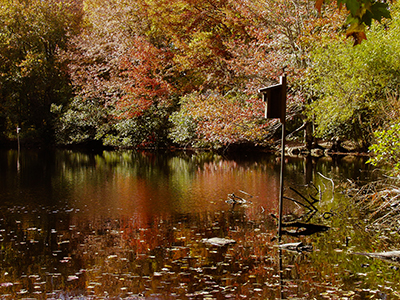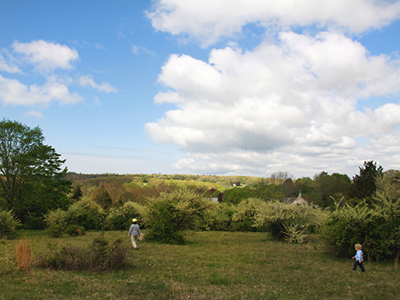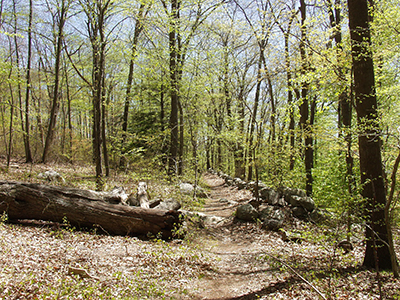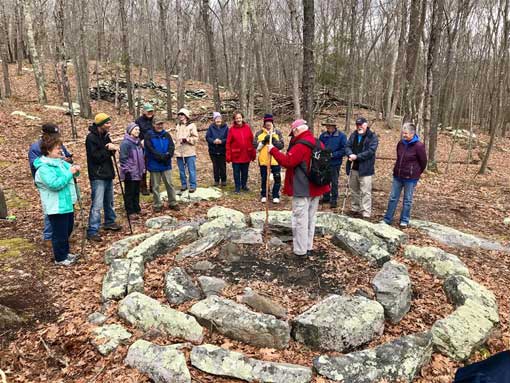Stewarded Lands
By taking actions that foster the basic building blocks of life – biological diversity, clean water, air and soil – land stewardship helps create and maintain healthy ecosystems. Like the old adage, “the true meaning of life is to plant trees under whose shade you do not expect to sit,” land stewardship is caring for specific parcels of land, regardless of ownership. It is, at its essence, a community-oriented action.
DPNC serves as a steward for more than 500 acres of public and private land. We work in partnership with state and local entities, public organizations and private landowners to ensure that properties under conservation are maintained to preserve robust and resilient habitats where both wildlife and humans can thrive, now and into the future.
Nature Center
Visitors connect with nature and the land around the Nature Center in a greenway of hundreds of acres of land. DPNC manages trails and wildlife habitat on more than 10 miles of trails through a culturally significant historic landscape of woodlands, meadows and wetlands on land owned by DPNC, the Denison Homestead, and Avalonia Land Conservancy.
The Nature Center features a natural history museum with live exhibits of native species of frogs, turtles and fish, snakes and birds of prey including American Kestrels, Broad-winged Hawks, Barred Owls, Red-tailed Hawks, Great Horned Owls, Eastern Screech Owls and Peregrine Falcons. In addition to the live exhibits, the museum contains traditional exhibits that showcase collections, including 300+ mounted birds, animal skulls, Connecticut insects, rocks and minerals and a diorama of backyard wildlife. A ‘Night in the Meadow’ theater showcases the Nature Center’s meadow after sunset, with the sounds and activities of fireflies and nocturnal animals. The Nature Center also houses a wildlife rescue and rehabilitation facility, an award-winning nature-based preschool, and multiple classroom spaces, both indoors and out.

Coogan Farm
In 2013, DPNC purchased the 45-acre Coogan Farm property on Greenmanville Avenue in Mystic. The property is an intact cultural landscape that includes open habitat, old stone foundations and walls, meadows and hedgerows, and a farmhouse and barn significant to the history of Mystic. On the banks of the Mystic River, the property has played a critical role in the life of Native Americans such as the local Pequot people for thousands of years. It was the first colonial farm along the east side of the Mystic River, owned by John Gallup in 1646, and later played a critical role in the development of the Mystic area of Greenmanville, serving as a farm providing food and produce to nineteenth-century shipbuilders at what is now Mystic Seaport.
DPNC’s acquisition of the property created an intact greenway linking the Nature Center on Pequotsepos Road all the way to Route 27 and across the river to the Peace Sanctuary. In addition, Coogan Farm protects two critical watersheds and a variety of early successional habitats, including young forest, shrub lands and meadows). The property is preserved in a USFW-conservation easement as critical habitat for the New England Cottontail rabbit.
Coogan Farm features an outdoor courtyard, outdoor gathering places, a renovated barn and farmhouse with classroom, exhibit, event, meeting and office spaces. The farm also features an heirloom orchard and a model regenerative Giving Garden that provides fresh vegetables and fruit to the food insecure of New London County, through the Gemma Moran United Way/Labor Food Bank.

Peace Sanctuary
The Peace Sanctuary is a 30-acre preserve located across the Mystic River from Coogan Farm. Also known as Great Hill, it has historic significance as a site for large gatherings for social justice during the late 1800s, and later as a summer camp for girls through the 1930s. The Sanctuary features sweeping views over the Mystic River and across to Coogan Farm from atop high ledges. A mile-long trail winds through the wooded property, past large oaks, American beech and tulip trees. Wild azaleas and pink lady slippers bloom in late May.Visitors may encounter remnants of the former Camp Mystic, such as old stone foundations, retaining walls and stone-lined cisterns.
Owned by the Mary Jobe Akeley Trust, the DPNC has stewarded the land for more than 30 years through conservation and education to ensure the intent of the trust is upheld. DPNC hosts a variety of school, summer camp and other programs at the Peace Sanctuary.

Gungywamp
The Gungywamp complex in northwest Groton is a state-owned property stewarded by the Nature Center. It features meandering stone walls, stone chambers, and the remains of scattered colonial sites amongst interesting geological features and irregular ridges, bogs and swamps. Paleo and woodland Native American artifacts (stone implements and pottery shards), colonial and Early American artifacts have been found on the site, but the usage of some of the structures still remains a mystery. DPNC leads regular hikes on the property, and private walks are available by appointment. In 2022 DPNC nominated the property for listing on the State Register of Historic Places as an archeological preserve.

Manatuck Preserve
DPNC manages a 205-acre conservation easement protecting a magnificent property and farm located south of Pine Point School in Stonington. The preserve is noted for its patchwork of grassland and forests, providing critical habitat for rare species, including Eastern Box Turtle, Wood Turtle, Bobolink, Kestrel and Bobcat. Admission to this private nature preserve is restricted to DPNC program participants on guided trips or by special arrangement.
Clipper Point
DPNC owns riverfront and wetland property at the north end of the Mystic River. This property is managed as open space for wildlife and to provide protection for the Mystic River watershed. There are no trails through this property and it is best accessed via kayak from the river. It is habitat for many riverine bird species including Swallows, as well as Kingfishers, Great Blue Herons and Egrets who take advantage of the low flowing coves in the upper reaches of the river to slowly stalk fish that become more visible in the shallow waters.

